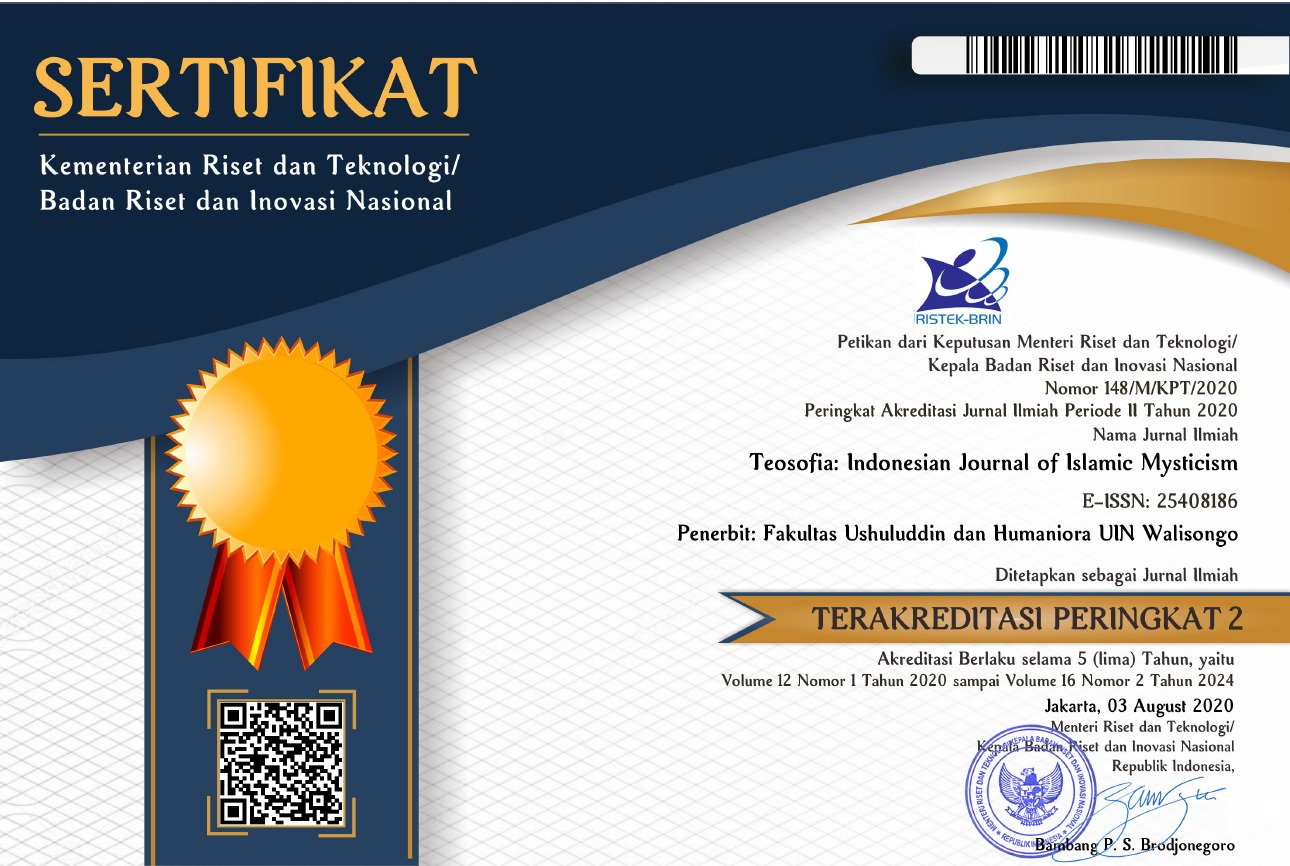Integrating Sufism and Environmental Ethics: A Comparative Study of al-Qushayrī and Holmes Rolston III
DOI:
https://doi.org/10.21580/tos.v14i1.25047Keywords:
al-Qushayrī, Holmes Rolston III, Environmental Ethics, Sufism, self-purification, systemic valuesAbstract
Abstract: The global environmental crisis intensifying in our era highlights the need for new conceptual approaches to address this existential issue. This study examines the relationship between environmental ethics and Sufism, based on systemic values inherent in Holmes Roston III and the Sufistic concept of self-purification. This qualitative research employs document analysis, focusing on al-Qushayrī's Subtle Allusions and Holmes Rolston III's Environmental Ethics, analyzed through a comparative framework and supported by secondary data. The study investigates the Sufistic concepts of ascetism, fear of God, and contentment alongside the systemic values of environmental ethics. It proposes the integrative concepts of prevent-repair, care-guard, and conviction-kindness as key outcomes. These findings underscore the importance of environmental ethics, personal spirituality, and intrinsic awareness, providing both theoretical and practical insights.
Contribution: Theoretically, this study advances the integration of Sufism and environmental ethics through combining Sufistic values (internal) with systemic values (external). It provides a framework for cultivating a balanced attitude and a conscious relationship with God, humans, and nature, grounded in Qur’anic principles and ecological awareness.
Downloads
References
Al-Qur’ān al-Karīm.
Abdel-Latif, Sara. "Sufi Master and Qur'an Scholar: Abū’l-Qāsim al-Qushayrī and the Laṭāʾif al-Ishārāt." Islam and Christian–Muslim Relations 24, no. 1 (2013): 144–46. https://doi.org/10.1080/09596410.2013.732270.
Abdelzaher, Dina M., Amr Kotb, and Akrum Helfaya. "Eco-Islam: Beyond the Principles of Why and What, and Into the Principles of How." Journal of Business Ethics 155, no. 3 (2019): 623–43. https://doi.org/10.1007/s10551-017-3518-2.
Abdullah, Amin. “Dimensi Etis-Teologis Dan Etis-Antropologis Dalam Pembangunan Berwawasan Lingkungan.” In Seminar Lingkungan Hidup. Salatiga, 1991.
———. Falsafah Kalam di Era Kontemporer. IRCISOD, 2022.
Abū ‘Alā al-‘Afīfī. Al-Taṣawwuf al-Thawra al-Rūḥiyya fī al-Islām. London: Hindawi, 2020.
Al‐Damkhi, Ali Mohamed. "Environmental Ethics in Islam: Principles, Violations, and Future Perspectives." International Journal of Environmental Studies 65, no. 1 (2008): 11–31. https://doi.org/10.1080/00207230701859724.
Ali Yafie. Merintis Fiqh Lingkungan Hidup. Jakarta: Ufuk Press, 2006.
Al-Qushayrī. Al-Risāla al-Qushairīya. Jedda: Dār al-Minhāj, 2017.
———. Laṭā’if al-Ishārāt. Vol. III. Lebanon: Dār al-Kutub al-ꜤIlmīya, 2007.
———. Laṭā’if al-Ishāra. Vol. I. Lebanon: Dār al-Kutub al-ꜤIlmīya, 2007.
———. Naḥw al-Qulūb al-Ṣaghīr wa al-Kabīr. Egypt: al-Hai’a al-Miṣrīya al-ꜤĀmma li al-Kitāb, 2008.
Anitra Nelson. Beyond Money: A Postcapitalist Strategy. London: Pluto Press, 2022.
Anne Becher and Joseph Richey. American Environmental Leaders: From Colonial Times to the Present. Vol. I. New York: Grey House Publishing, 2008.
Armahedi Mahzar. Islam Masa Depan. Bandung: Pustaka, 1993.
Al-ShāfiꜤī, Muḥammad Idrīs. Al-Umm. Vol. II. Dār al-Wafā, 2001.
Basyūnī, Ibrāhīm. Al-Imām al-Qushayrī Ḥayātuhu Wa Taṣawwufuhu Wa Ṡaqāfatuhu. Egypt: Maktaba al-Ādāb, 1992.
Belhaj, Abdessamad. "Legal Knowledge by Application: Sufism as Islamic Legal Hermeneutics in the 10th/12th Centuries." Studia Islamica 108, no. 1 (2013): 82–107. https://doi.org/10.1163/19585705-12341276.
Blackburn, Simon. Kamus Filsafat. Translated by Yudi Santoso. II. Yogyakarta: Pustaka Pelajar, 2021.
Chiabotti, Francesco. "The Spiritual and Physical Progeny of ʿAbd Al-Karīm al-Qushayrī: A Preliminary Study in Abū Naṣr al-Qushayrī's (d. 514/1120) Kitāb al-Shawāhid Wa-l-Amthāl," January 1, 2013. https://doi.org/10.1163/22105956-12341246.
"Dr. Holmes Rolston III - 2005 | Villanova University." Accessed June 2, 2024. https://www1.villanova.edu/villanova/president/university_events/mendelmedal/pastrecipients/holmes_rolston.html.
Egri, Carolyn P. "Spiritual Connections with the Natural Environment: Pathways for Global Change."Organization & Environment" 10, no. 4 (1997): 407–31. https://doi.org/10.1177/192181069701000405.
Goreau, Thomas J F, and Raymond L Hayes. "2023 Record Marine Heat Waves: Coral Reef Bleaching HotSpot Maps Reveal Global Sea Surface Temperature Extremes, Coral Mortality, and Ocean Circulation Changes." Oxford Open Climate Change 4, no. 1 (2024): kgae005. https://doi.org/10.1093/oxfclm/kgae005.
Guessoum, Nidhal. Islam's Quantum Question: Reconciling Muslim Tradition and Modern Science. London: I. B. Tauris, 2011.
Hammo, Bassam H., Azzam Sleit, Aladdin Baarah, and Hani Abu-Salem. "A Computational Approach for Identifying Quranic Themes." International Journal of Computer Processing of Languages 24, no. 02 (2012): 189–206. https://doi.org/10.1142/S1793840612400120.
Hayat, Imran, Muhammad Sajad Malik, Muhammad Waris Ali, Muhammad Husnain, Muhammad Sharif, and Abdul Haleem. "The Role of Islamic Environmental Ethics in the Alleviation of Climate Challenges and the Preservation of the Ecosystem." Russian Law Journal 11, no. 11S (2023): 395–404. https://doi.org/10.52783/rlj.v11i11s.1967.
Helli, Abdulrahman. "Does the Qurʾān Offer Foundational Principles for Environmental Ethics?" Journal of Islamic Ethics 1, (2024): 1–25. https://doi.org/10.1163/24685542-20240003.
Himawanti, Izza, Imam Faisal Hamzah, and Muhammad Faiq. "Finding God's Way: Spiritual Well-Being on the People Who Do Tirakat Mlaku." Teosofia: Indonesian Journal of Islamic Mysticism 11, no. 1 (2022): 43–62. https://doi.org/10.21580/tos.v11i1.10721.
"Holmes Rolston III | Environmental Ethics, Natural Theology & Conservation | Britannica," May 2, 2024. https://www.britannica.com/biography/Holmes-Rolston-III.
Hope, Marjorie, and James Young. "Islam and Ecology." CrossCurrents 44, no. 2 (1994): 180–92.
Hossein Nasr. Islam Dan Nestapa Manusia Modern. Bandung: Pustaka, n.d.
———. Man and Nature: The Spiritual Crisis of Modern Man. London: Unwin Hyman Limited, 1990.
———. Tasawuf Dulu dan Sekarang. Translated by Abdul Hadi W. M. I. Banguntapan, Yogyakarta: IRCiSoD, 2020.
Husain, Majid. Environment and Ecology: Biodiversity, Climate Change, and Disaster Management. III. Delhi: Access Publishing, 2015.
Ḥusayn, ‘Abdullāh. Al-Taṣawwuf wa al-Mutaṣawwifa. London: Hindawi, 2017.
Ibrahim Abdul-Matin. Green Deen: What Islam Teaches About Protecting the Planet. San Francisco: Berrett-Koehler Publishers, 2010.
Institut Agama Islam Negeri Syarif Hidayatullah, ed. Ensiklopedi Islam Indonesia. Jakarta: Djambatan, 1992.
Irawan, Bambang. "Environmental Protection from the Perspectives of Indonesian, Sufi, and UK Muslim Environmentalists." Heritage of Nusantara: International Journal of Religious Literature and Heritage 5, no. 2 (2016): 230–61. https://doi.org/10.31291/hn.v5i2.151.
Islam, Md. "Old Philosophy, New Movement: The Rise of the Islamic Ecological Paradigm in the Discourse of Environmentalism." Nature and Culture 7 (2012): 72–94. https://doi.org/10.3167/nc.2012.070105.
Islam, Md Saidul. "Old Philosophy, New Movement: The Rise of the Islamic Ecological Paradigm in the Discourse of Environmentalism." Nature and Culture 7, no. 1 (2012): 72–94. https://doi.org/10.3167/nc.2022.170104.
James Lovelock. Gaia: A New Look at Life on Earth. New York: Oxford University Press, 2000.
Jenkins, Willis. "Islamic Law and Environmental Ethics: How Jurisprudence (Usul al-Fiqh) Mobilizes Practical Reform." Worldviews 9, no. 3 (2005): 338–64. https://doi.org/10.1163/156853505774841641.
Joy A. Palmer, David E. Cooper, and Peter Blaze Corcoran, eds. Fifty Key Thinkers on the Environment. London: Routledge, 2003.
Keeler, Annabel. "Sūfī Tafsīr as a Mirror: Al-Qushayrī the Murshid in His Latācif al-Ishārāt." Journal of Qur'anic Studies 8, no. 1 (2006): 1–21. https://doi.org/10.3366/jqs.2006.8.1.1.
Khalid, Fazlun M. Signs on the Earth: Islam, Modernity and the Climate Crisis. Markfield, Leicestershire: Kube Publishing, 2019.
Longo, F. Dominic. Spiritual Grammar: Genre and the Saintly Subject in Islam and Christianity. USA: Fordham University Press, 2017.
Madjid, Nurcholish. Islam Doktrin Dan Peradaban: Sebuah Telaah Kritis Tentang Masalah Keimanan, Kemanusiaan, Dan Kemodernan. Jakarta: Paramadina, 1992.
Mālik ibn Anas. Al-Muwaṭṭā'. Mu’assasah Zaid bin Sulṭān, 2004.
Mojaddedi, Jawid A. "Legitimizing Sufism in Al-Qushayri's' Risala.'" Studia Islamica, no. 90 (2000): 37. https://doi.org/10.2307/1596163.
Munji, Ahmad. “رعاية البيئة في التصوف الإسلامي.” Teosofia: Indonesian Journal of Islamic Mysticism 5, no. 2 (2016): 133–45. https://doi.org/10.21580/tos.v5i2.1726.
Muslimin, J. M., Lutfi Chakim, and Fauzani. "Maqasid Al-Shariah in Environmental Conservation of Yusuf al-Qaradawi's Perspective:" In Proceedings of the 1st International Conference on Recent Innovations, 869–77. Jakarta, Indonesia: SCITEPRESS - Science and Technology Publications, 2018. https://doi.org/10.5220/0009919008690877.
Muvid, Muhamad Basyrul, and Nur Kholis. "Contribution of Sufism Trilogy in the Formation of Religious Behavior: A Proposed Model," March 1, 2024. https://openurl.ebsco.com/contentitem/gcd:176414374?sid=ebsco:plink:crawler&id=ebsco:gcd:176414374.
Nahdi, Maizer Said, and Aziz Ghufron. “Etika Lingkungan Dalam Perspektif Yūsuf Al-Qaraḍāwy.” Al Jamiah Vol. 44, No. No.1 (2009). https://digilib.uin-suka.ac.id/id/eprint/741/.
Norton, Bryan G. "Conserving Natural Value." Environmental Ethics 18, no. 2 (1996): 209–14. https://doi.org/10.5840/enviroethics199618233.
Nugraha, Aulia, and Naupal Asnawi. "Dialogue Between Islam and Environmental Ethics Through Seyyed Hossein Nasr's Thought." International Review of Humanities Studies 4, no. 3 (2019). https://scholarhub.ui.ac.id/irhs/vol4/iss3/2.
Parray, Tauseef Ahmad. "Recent Qur’ānic Scholarship: A Critical Evaluation of Ziauddin Sardar's 'Reading the Qur'an.'" Hamdard Islamicus 42, no. 4 (2019). https://doi.org/10.57144/hi.v42i4.30.
Paul Hawken. Blessed Unrest: How the Largest Movement in the World Came into Being and Why No One Saw It Coming. New York: Viking, 2007.
Pojman, Louis P. Environmental Ethics: Readings in Theory and Application. 7th edition. Boston, MA: Cengage Learning, 2015.
Al-Qaraḍāwī, Yūsuf. Ri‘āya al-Bī’a fi Sharī‘at al-Islām. Cairo: Dār al-Shurūq, 2001.
Resnik, David B. Environmental Health Ethics. Cambridge: Cambridge University Press, 2012.
Robinson, Deena. "The Biggest Environmental Problems of 2021." Earth.org, September 16, 2023. https://earth.org/the-biggest-environmental-problems-of-our-lifetime/.
Rolston, Holmes. Environmental Ethics: Duties to and Values in the Natural World. Ethics and Action. Philadelphia: Temple Univ. Press, 1988.
———. Naturalizing Values: Organisms and Species. North American Association on Social Philosophy, 1998.
———. Science and Religion: A Critical Survey. New York: Random House, 1987.
———. "The Future of Environmental Ethics." Royal Institute of Philosophy Supplements 69 (2011): 1–28. https://doi.org/10.1017/S135824611100018X.
Rolston, Holmes, Sam Lebenson, Justin Wong, and Philosophy Documentation Center. "An Interview with Holmes Rolston III." The Harvard Review of Philosophy 29 (2022): 131–36. https://doi.org/10.5840/harvardreview2022293.
Safdar, Saad Saood, and Ghulam Shams-Ur-Rehmam. "The Roots of the Ecological Crisis in the Theological and Philosophical Landscape of Modern Civilization: An Analysis of Seyyed Hossein Nasr's Perspective." Islamic Studies 60, no. 3 (2021): 287–308. https://doi.org/10.52541/isiri.v60i3.1847
Sardar, Ziauddin. Reading the Qur'an: The Contemporary Relevance of the Sacred Text of Islam. London: Hurst & Company, 2011.
Simuh. Pergolakan Pemikiran Dalam Islam. Cetakan pertama. Baturetno, Banguntapan, Yogyakarta: IRCiSOD, 2019.
Siroj, Said Aqil. Allah Dan Alam Semesta: Perspektif Tasawuf Falsafi. Jakarta: Yayasan Said Aqil Siroj, 2021.
Smith, Kimberly K. Exploring Environmental Ethics: An Introduction. AESS Interdisciplinary Environmental Studies and Sciences Series. New York, NY: AESS, Springer, 2018.
Soemarwoto, Otto. Indonesia Dalam Kancah Isu Lingkungan Global. Jakarta: Gramedia Pustaka Utama, 1991.
Suzuki, Nobuhiro, Rosa M. Rivero, Vladimir Shulaev, Eduardo Blumwald, and Ron Mittler. “Abiotic and Biotic Stress Combinations.” The New Phytologist 203, no. 1 (2014): 32–43. https://doi.org/10.1111/nph.12797.
Sviri, S. “Review of Al-Qushayrī, Principles of Sufism, Trans. B.R. Von Schlegell, Introduction: H. Algar, Berkeley 1990."Jerusalem Studies in Arabic and Islam 19 (1995).
Svoboda, Toby. "Why There Is No Evidence for the Intrinsic Value of Non-Humans." Ethics and the Environment 16, no. 2 (2011): 25–36. https://doi.org/10.2979/ethicsenviro.16.2.25.
Ta'a, Azman, Mohd Syazwan Abdullah, Abdul Bashah Mat Ali, and Muhammad Ahmad. "Themes-Based Classification for Al-Quran Knowledge Ontology." In the 2014 International Conference on Information and Communication Technology Convergence (ICTC), 89–94, 2014. https://doi.org/10.1109/ICTC.2014.6983090.
Tracy, Sarah J. Qualitative Research Methods: Collecting Evidence, Crafting Analysis, Communicating Impact. Second edition. Hoboken, NJ: Wiley-Blackwell, 2020.
Wang, Li, Feng Wei, and Xin-an Zhang. "Why Does Energy-Saving Behavior Rise and Fall? A Study on Consumer Face Consciousness in the Chinese Context." Journal of Business Ethics 160, no. 2 (2019): 499–513. https://doi.org/10.1007/s10551-018-3944-9.
Wilber, Ken. The Marriage of Sense and Soul: Integrating Science and Religion. Boston: Shambhala Publications, 1998.
Yafeh, H. Lazarus. Studies in Al-Gazālī. Jerusalem, 1975.
Downloads
Published
How to Cite
Issue
Section
License

This work is licensed under a Creative Commons Attribution-ShareAlike 4.0 International License.
Copyright
The copyright of the received article shall be assigned to the journal as the publisher of the journal. The intended copyright includes the right to publish the article in various forms (including reprints). The journal maintains the publishing rights to the published articles. Therefore, the author must submit a statement of the Copyright Transfer Agreement.*)
Licensing

This work is licensed under a Creative Commons Attribution-ShareAlike 4.0 International License.
In line with the license, authors are allowed to share and adapt the material. In addition, the material must be given appropriate credit, provided with a link to the license, and indicated if changes were made. If authors remix, transform or build upon the material, authors must distribute their contributions under the same license as the original.
_______
*) Authors whose articles are accepted for publication will receive confirmation via email and send a Copyright Transfer Agreement.








